|
November 10


The Beginning of Pat O"Brien's December 3, 1933 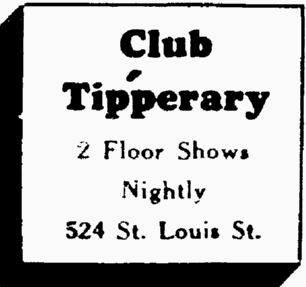 During prohibition, North Carolina native Charlie Cantrell was running rum in Plaquemine. He was also a master of the
"Shake Up" which involved mixing grain alcohol with flavorings to create concoctions tasting like gin, whiskey,
rum, and other liquors. "Sometimes it wasn't too good, but it could get you drunk", said Cantrell. Benson
Harrison "Pat" O'Brien was a customer who bootlegged liquor back home to Birmingham. They became friends. O'Brien, after several business endeavors, moved to New Orleans and ran a
speakeasy. After prohibition, on December 3, 1933 he opened a package liquor store at Royal and St.
Peter Street. In 1934 he opened Club Tipperary at 524 St. Louis. (The advertisement at the right ran in the Times-Picayune
on March 18, 1934.) Cantrell financed it. Then, as equal partners, they moved to another location in the 600 block of St.
Peter Street across from the original store. Cantrell later bought 10% of O'Brien's share, making him the controlling
partner. In December, 1942 they moved to the current location of the world famous Pat O'Brien's bar at 718 St. Peter
and called it Pat O'Brien's. The building was historic long before
Cantrell and O'Brien made it famous. Built in 1791, it housed the first Spanish theater in the United States.
The famous Hurricane cocktail was first mixed there 146 years later. In 1937 a liquor salesman was hawking 60 bottles
of rum at a bargain basement price and would even throw in 15 dozen glasses shaped like the globes of oil fueled hurricane
lamps. The rum wasn't selling as Cantrell had hoped, so he decided to experiment. He mixed 4 ounces of it with red fruit
juice and sugar, and instructed his waiters to tout these drinks. Customers loved them and their glasses. Cantrell,
a savvy businessman began selling both. That same year (1937),
Mercedes Paulson and Sue Wheeler first performed together at the dueling pianos (thought to be the first in the country).
"Sue" was actually Sara Belle Wheeler, a native of Vicksburg who had been educated in New Orleans. She passed
away on Saturday, March 10, 1956 at the age of 38 after having played at Pat O's for 19 years. Mercedes
LeCorgne Paulson, a native New Orleanian, died on Thursday, April 10, 1980 at the age of 74. Her booming
baritone, which graced main bar for 32 years, is still remembered by many. She retired from Pat O'Brien's in 1968. 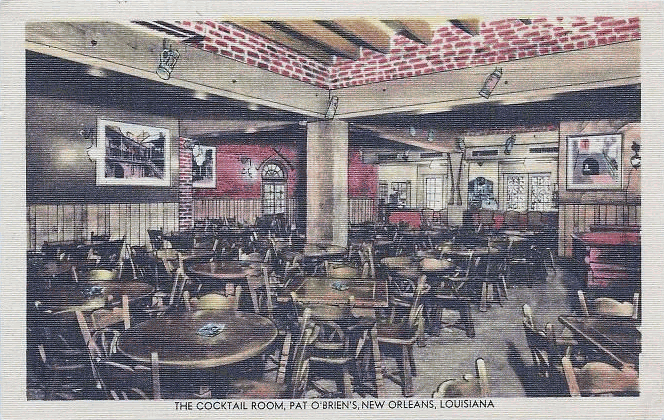 Charlie ran the business. Pat handled the customers. They were perfect partners for the business. During World War II,
Cantrell worked in a defense shipyard where he met George Oechsner, who would become the bars General Manager, taking Cantrell's
place and becoming part owner in 1947. In 1979 Oechsner's son George "Sonny" Jr. took over the role. It was
Sonny's idea to begin franchising and Pat O'Brien's bars sprouted up in Orlando, San Antonio, Memphis,
Cancun, and Destin. Sonny also added a restaurant upstairs, purchased
a building on Bourbon Street for expansion, opened a location at the Jaz Brewery, introduced an online catalog for selling
branded items, and acquired a bottling plant. The guys who ran
the place for so many years are all gone now. Pat O'Brien died on November 10, 1983. Geroge D.
Oechsner Jr. followed on December 11, 1990. Charlie Cantrell passed away on March 23, 1993.
Sonny died on March 12, 2012. But the business the two bootleggers started and the local men continued
remains, now an iconic New Orleans bar known around the world. Upon
Sonny's death, his daughter Shelly Oechsner Waguespack became Pat O'Brien's president and sole owner.
1947 postcard
Servant of
Slaves A New Orleans lady, born in 1813 to a wealthy
Frenchman and a quadroon free woman of color, who rejected the social norms of her times is now the first U.S. native-born
African American religious leader whose cause for canonization was officially opened by the Catholic Church.
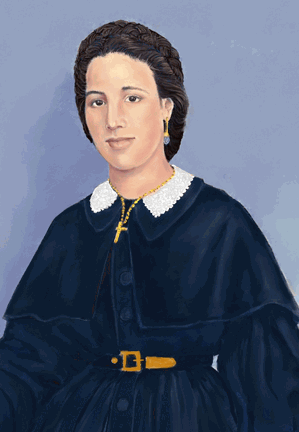 Henriette Delille's birth was the results of a placage, an extralegal "common law" system which became
institutionalized in our city during the Colonial Era. The arrangements included contracts or negotiations between white
men and free women of color which stipulated the financial and/or housing arrangements for woman, the settlement of property,
and, many times, paternal recognition of any children the union produced. The woman's mother usually negotiated the terms
of the agreements, including the financial payment to the parent. To our modern sensibilities, such arrangements
seem arcahaic but they were acceptable in their day and provided mixed-race women with social prestige and financial security. Henriette Delille's birth was the results of a placage, an extralegal "common law" system which became
institutionalized in our city during the Colonial Era. The arrangements included contracts or negotiations between white
men and free women of color which stipulated the financial and/or housing arrangements for woman, the settlement of property,
and, many times, paternal recognition of any children the union produced. The woman's mother usually negotiated the terms
of the agreements, including the financial payment to the parent. To our modern sensibilities, such arrangements
seem arcahaic but they were acceptable in their day and provided mixed-race women with social prestige and financial security.
Dellille had been groomed for such an arrangement. Her mother taught her French literature, music, dancing, and nursing.
Her mother kept an eye on Henriette when she attended many quadroon balls, which were the young women's introductions
into the social world which would lead to their arranged "marriages". An independent woman and a feminist
(before the word had been coined), Delille became a social worker, educator, and a nun. Ironically, the most popular
location for hosting quadroon balls would later become the convent and school of the order of religious sisters founded by
Henriette Delille. During the 1820s, Delille and Juliette Gaudin, a young Cuban woman, began
aiding slaves, orphan girls, the uneducated, the sick and the elderly people of color in New Orleans. In
1835, at the age of 22, she sold all of her property with the intention of founding a community of women to teach for
free girls of color. Numerous recordings in archival records at the Saint Louis Cathedral show that, at the age of
23, Henriette had begun her apostolic ministry as baptismal sponsor and witness for slaves. On November
21, 1836, a small unrecognized congregation or order of nuns, the Sisters of the Presentation of the Blessed Virgin
Mary, was organized. The original members consisted of Henriette, Juliette Gaudin, six other young Créole women, and
a young French woman. After several failed attempts, Delille and Juliette Gaudin received permission from the diocese to
begin a new religious order. Their board was composed of a director, president, vice-president, secretary, treasurer and
vice-treasurer. The sisters and laypersons of this society were called upon to teach religious principles and the most important
points of Christian morality. In 1837, Father Etienne Rousselon secured formal recognition of the new congregation
from the Holy See. Sanctioned by the church, their main purpose was to care for slaves, the sick, and the poor.
Six years later, at the urging of Jeanne Marie Aliquot (an early supporter of St. Augustine Church)
and the counseling of Pere Etienne Rousselon (vica-general of the diocese), Delille and Gaudin knelt publicly at the
altar of St. Augustine Church on November 21, 1842 and pledged to live in community to work for orphan
girls, the uneducated, the poor, the sick and the elderly among the free people of color, thus founding the Congregation
of the Sisters of the Holy Family -- the second-oldest African-American congregation of religious women. In
1843, catechism classes were conducted for adults and children on St. Augustine's property at Bayou Road (now Governor Nicholls).
Delille and Gaudin were later joined by Josephine Charles; the first three novices, Delille, Gaudin and Charles, are considered
the founders of the congregation. Although the primary work of the sisters was in the area of education, during her tenure
as head of the order, Delille made it possible for the order to build a home for the sick, aged, and poor Black residents
of the city. By 1847 the apostolate of the three sisters was supported by an association of men and
women incorporated as the Association de la Sainte Famille. Their mission was for the relief of infirm and indigent persons.
They eventually acquired a building that was known as Hospice de la Societe de la Sainte Famille. Through legal incorporation
and fund-raising, they erected the building on two lots situated on St. Bernard between Plauche and Villere streets. The
hospice was blessed on June 10, 1849. When Henriette’s mother died in
1848, she inherited $1,200 which she used, along with borrowed money, to arrange for the purchase of property on Bayou Road
and declared this transaction to be solely for the purpose of establishing an institution for the religious education according
to Catholic doctrine for persons of color. This became the orders first "House" (convent and school) of The
Sisters of the Holy Family. But it wasn't until October 15, 1852, when Henriette, Juliette, and Josephine
pronounced first vows of poverty, chastity, and obedience to God in St. Augustine Church before Père Rousselon,
that they first wore the black habit of a religious order.
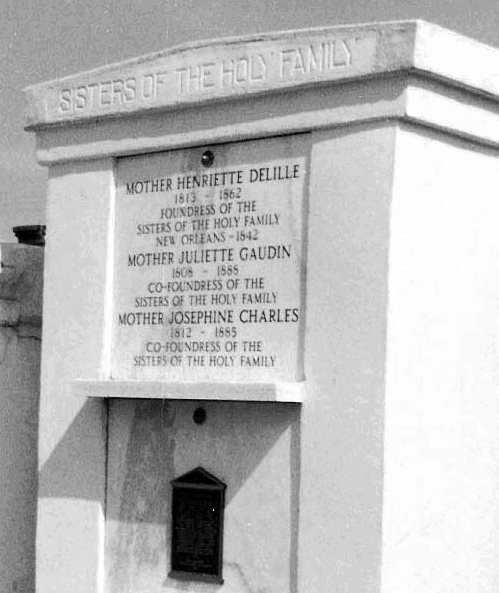 Henriette Delille passed away on November 16, 1862 at the age of 50. It is thought that her
death was a result of tuberculosis. Her funeral was held at St. Augustine church. She is buried in St. Louis Cemetery
No. 2. The order she founded continued her legacy by opening a convent school on Chartres street
on December 3, 1867, five years after her death. In 1880 they moved the mother house at 717 Orleans Avenue,
between Bourbon and Royal streets -- the site of the Orleans Theatre, the Quadroon balls, the First District Court, and finally
the Bourbon Orleans Hotel ( Photo of the school.convent) In 1883, the order opened a convent in Opelousas. In 1875 the opened a home for aged and
infirm people of color on St. Bernard Avenue between Villere and Marais streets. An orphanage was opened on
June 22, 1879 on Conti Street. In 1892, they opened school for boys and St. John Berchman's Orphan Asylum for
girls. At the time of her death, her order included twelve nuns. 1909, it had grown to
150 members, and operated parochial schools in New Orleans that served 1,300 students. By 1950, membership in the order
peaked at 400. Her Sisters have served the poor by operating free schools for children, nursing homes, and retirement
homes in Louisiana, Texas, California, Washington, D.C., Oklahoma, Alabama, Florida, Belize, Panama, and Nigeria.
In April 1988, Mother Rose de Lima Hazeur, Superior General of the Sisters of the Holy Family. requested
Archbishop Philip M. Hannan to initiate the canonization of Henriette Delille. In 1989 the order formally opened its
cause with the Vatican. On November 10, 2006, the decree of judicial validity was issued in the
investigation into the life, virtues and reputation of sanctity of Mother Henriette Delille. She was declared venerable
in 2010. A prayer room in the rear of St. Louis Cathedral (where slaves were thought to have been
baptized) was commissioned by its rector Reverend Monsignor Crosby W. Kern in her honor.
In
2011, the City of New Orleans renamed St. Claude Street in Treme in her honor. Henriette Delille Street now runs at
what was the 1000 through 1800 blocks of St. Claude, from St. Philip Street, at the edge of Louis Armstrong Park, to Pauger
Street, where St. Claude Street and McShane Place come together to form St. Claude Avenue. The photo
above was taken by Sister Doris Goudeaux in 2008 of the three founding members' tomb in St. Louis Cemetery No. 2.
In summing up Henreitte Delille's life and mission, Sylvia Thibodeaux, a modern Sister of the Holy Family, told the
Los Angeles Times, "She was the servant of slaves. You can't get more committed than that.
Our Old and Beloved Building
The
Cabildo
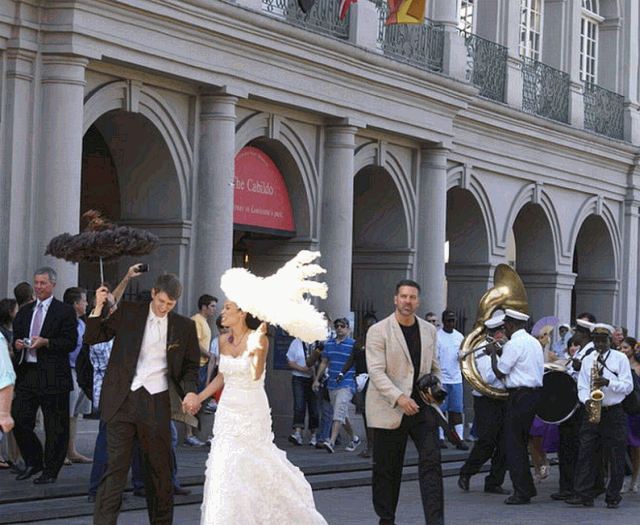 On November 10, 1797, Don Gilberto Guillemard, Lieutenant Colonel of the Royal Army and Commander of the
post, informed the Cabildo (the Spanish governmental body in New Orleans) that by order of El Baron de Carondelet he had
made the plan for the construction of the Cabildo Building, and is at present directing its construction. He stated that
compensation had been promised him for this work. Commissioners agreed to pay him two hundred Pesos at this time. Most of the original Cabildo building was lost in the Great New Orleans Fire
of 1788 which destroyed 856 of the 1,100 structures from Conti to St. Phillip and Dauphine almost to the river on March
21, 1788. The arched walls and brick floor of the Corps de Garde (guardhouse), built in 1751 survived.
In 1795 Don Andrés Almonester y Roxas agreed to pay for the construction of a new
building (mentioned above). It was completed in 1799. It was used as city hall, a courthouse and a prison. It
was designed by Gilberto Guillemard, who also designed St. Louis Cathedral and the Presbytere.
The Baroness Micaëla Almonester de Pontalba, the daughter of Almonester y Roxas proposed
renovations to the Cabildo in the 1840s to match new construction on neighboring land she had inherited from her father.
At this time, an entire third story was added to the building, and massive cast-iron gates were erected at the main entrance.
The French-syle mansard roof was added in 1847, replacing the original flat Spanish roof and balustrade. Marquis de Lafayette used the Sala Capitular as his residence when he
visited New Orleans in 1825.
It was the site of the
Louisiana Purchase transfer ceremonies on December 20, 1803 which nearly doubled the size of the United States.
It was used by the New Orleans city council until 1853 when Gallier Hall was dedicated as the city hall. The Spanish seal on the pediment was blasted off after the U.S. took over Louisiana, and was left blank for
two decades until Pietro Cardelli, an Italian sculptor, was hired to create current scend of an eagle, American flag,
cannons, and cannonballs. The wrought iron balcony, whose construction was overseen by Isleño artisan Marcellino Hernandez
remained untouched, even with its crown and a rosary design which reflects the Spanish institutions of the crown and the church.
The building's main hall, the Sala Capitular ("Capital Room") on
the second floor, was originally utilized by the Spanish as a courtroom (1799-1803), the superior court in the Louisiana territorial
period (1803-1812), and the later the Louisiana Supreme Court after the Civil War (1868-1910), and was the site of several
landmark court cases, including the 1896 Plessy v. Ferguson decision which uphelp the legality of racial segregation
if it were separate but equal" In 1895 artist and preservationist William Woodward (who helped found the Tulane
School of Architecture) led a successful campaign to have the historic building preserved and restored rather than demolished
due to its state of decay and neglect. In 1908 the Cabildo became the home of the Louisiana State Museum which actively
displays historical exhibits there. In 1937 the structure was completely
renovated and repaired, while work was also done on it's twin, the Presbytere. It was declared a National Historic
Landmark in 1960. A massive fire on May 11, 1988 caused extensive damage, which severly damaged the
cupola and upper floor. In 1994 it reopened to the public. Hurricane Katrina brought only minor damages.
Within days, the Louisiana State Police and the Louisiana State Troopers used the business offices of the Cabildo. More
than 1,000 artifacts and original works of art, including Eugene Louis Lami’s huge 1839 painting “The Battle
of New Orleans.” and thework of John James Audubon are on display. Photo "Wedding Reception Second Line
in front of the Cabildo, Jackson Square, New Orleans" on May 14, 2011 by Infrogmation.
Streetcar service after Hurricane Katrina from Lee Circle to Napoleon Avenue in Uptown New Orleans was restored November
10, 2007 at 2:00 p.m.
A native of Donaldsonville, Marion James Porter grew up in New Orleans and attended Straight College.
He did photographic work for the Louisiana Weekly and for Black Data Weekly newspapers and also served
as the local photographer for such national publications as Ebony, Jet, and Black Enterprise. He also owned Porter's
Photo News. Among his subjects over the years were celebrities such as President John F. Kennedy, Reverend Martin Luther
King, Jr., Thurgood Marshall, Halie Selassie, Louis Armstrong, Duke Ellington, Jackie Robinson, Joe Louis, and Jesse Owens.
His work documents the full range of African American activity in the Crescent City, from social occasions and sporting
events to political rallies and civil rights protests. Porter was a member of a number of local organizations, including
the NAACP, the Urban League, and the Zulu Social Aid and Pleasure Club. He was a veteran of World War II, having seen action
at the Battle of the Bulge under the command of General George Patton. Marion Porter died of cancer in New Orleans on
November 10, 1983 at the age of 74. (From the New Orleans Public Library)
Willie Nelson's recording of City of New Orleans was the RPM Country Tracks number-one single on November
10, 1984.
The Mary Louise Kennedy Genella House at 5022-5028 Prytania Street was placed on the Nationa Hisoric Register of Historic
Places on November 10, 1982.
Bob Dylan performed at the Saenger Performing Arts Center on November 10 and 11, 1981.
Building plans for Barkers Department Store/A & P Food Store at 9701 Chef Menteur Highway were submitted by Maurice E.
Reilly Jr. on November 10, 1967.
Plans of the Oak Grove Baptist Church at 3122 Mistletoe Street were submitted by Patrick M. Allison on November 10,
1949.
An ordinance dedicating the neutral ground on Canal Blvd. from City Park Ave. to Robt. E. Lee Boulevard as a memorial parkway
known as an Outdoor Hall of Fame, to perpetuate the memory of citizens outstanding in social, civic, or economic welfare
was passed on November 10, 1936.
On November 10, 1927, Francis J. MacDonnell submitted plans for the William B. Reily Building at 640 Magazine
Street.
Plans for Lane Cotton Mills' Mill #6 at 424 Cadiz Street were submitted by Favrot and Livaudais on November 10, 1922.
In the Catholic Church, Our Lady of Prompt Succor is the Patroness of Louisiana. on November
10, 1895, Pope Leo XIII granted/approved the solemn crowning of the statue, an honor carried out by New Orleans
Archbishop Janssens. In 1912 this devotion was officially approved by Rome. The statue of Our
Lady of Prompt Succor, the first crowned, was moved from the Old Ursuline convent in the French Quarter to the National Shrine
of Our Lady of Prompt Succor, located on the State Street campus of Ursuline Academy and
Convent. The National Votive Shrine of Our Lady of Prompt Succor was constructed during the 1920s and consecrated on January
6, 1928. The Shrine is the responsibility of the Ursuline Sisters of the Roman Union, Central Province.
A city ordinance which repealed ordinance No. 8137 A.S., being an ordinance dedicating that portion of ground at the foot
of Canal Street as a public place to be known as Whitney Place, rededicated and named said place Liberty Place was passed
on November 10, 1882.
During the First American Chess Congress, held in New York from October 6 to November 10, 1857,
Paul Morphy defeated each of his rivals, including James Thompson, Alexander Beaufort Meek, and German masters Theodor Lichtenhein
and Louis Paulsen, the latter two in the semifinal and final rounds. Morphy was hailed as the chess champion of the United
States, but he appeared unaffected by his sudden fame. According to the December 1857 issue of Chess Monthly, "his
genial disposition, his unaffected modesty and gentlemanly courtesy have endeared him to all his acquaintances." On the
afternoon of July 10, 1884, Morphy was found dead in his bathtub in New Orleans at the age of forty-seven.
According to the autopsy, Morphy had suffered a stroke brought on by entering cold water after a long walk in the midday
heat. The Morphy mansion, sold by the family in 1891, was the site
of Brennan's restaurant.
On June 18, 1812, the United States declared war on Great Britain. To supplement
their navy, the United States offered letters of marque to private armed vessels. New Orleans issued six such
letters, primarily to smugglers who worked with Jean Lafitte at Barataria. The smugglers often held letters of marque from
multiple countries, authorizing them to capture booty from differing nations. They submitted booty from captured British
ships to the American authorities at New Orleans, while booty from all other ships was often channelled for sale on the
markets through Lafitte's operation. As the smuggling operations reduced the amount of revenue collected by customs
offices, American authorities were determined to halt Barataria's operations. Because the US Navy did not have enough ships
to act against the Baratarian smugglers, the government turned to the courts. On November 10, 1812, the
United States District Attorney John R. Grymes charged Lafitte with "violation of the revenue law".
Three days later, 40 soldiers were sent to ambush the Baratarians; they captured Lafitte, his brother Pierre, and 25
unarmed smugglers on November 16, and confiscated several thousand dollars of contraband. Officials
released the smugglers after they posted bond, and they disappeared, refusing to return for a trial. Ironically, the Chalmette Monument and Grounds were incorporated into the
Jean Lafitte National Historical Park and Preserve on November 10, 1978, exactly 116 years after Jean Laffite was
charged with with "Violation of the revenue law". Chalmette Monument and Grounds were established
on March 4, 1907 to commemorate the site of the Battle of New Orleans. It was transferred from the War Department
to the National Park Service on August 10, 1933 and redesignated Chalmette National
Historical Park on August 10, 1939. It was listed on the National Register of Historic Places
on July 1, 1974.
|




 During prohibition, North Carolina native Charlie Cantrell was running rum in Plaquemine. He was also a master of the
"Shake Up" which involved mixing grain alcohol with flavorings to create concoctions tasting like gin, whiskey,
rum, and other liquors. "Sometimes it wasn't too good, but it could get you drunk", said Cantrell. Benson
Harrison "Pat" O'Brien was a customer who bootlegged liquor back home to Birmingham. They became friends.
During prohibition, North Carolina native Charlie Cantrell was running rum in Plaquemine. He was also a master of the
"Shake Up" which involved mixing grain alcohol with flavorings to create concoctions tasting like gin, whiskey,
rum, and other liquors. "Sometimes it wasn't too good, but it could get you drunk", said Cantrell. Benson
Harrison "Pat" O'Brien was a customer who bootlegged liquor back home to Birmingham. They became friends. Charlie ran the business. Pat handled the customers. They were perfect partners for the business. During World War II,
Cantrell worked in a defense shipyard where he met George Oechsner, who would become the bars General Manager, taking Cantrell's
place and becoming part owner in 1947. In 1979 Oechsner's son George "Sonny" Jr. took over the role. It was
Sonny's idea to begin franchising and Pat O'Brien's bars sprouted up in
Charlie ran the business. Pat handled the customers. They were perfect partners for the business. During World War II,
Cantrell worked in a defense shipyard where he met George Oechsner, who would become the bars General Manager, taking Cantrell's
place and becoming part owner in 1947. In 1979 Oechsner's son George "Sonny" Jr. took over the role. It was
Sonny's idea to begin franchising and Pat O'Brien's bars sprouted up in  Henriette Delille's birth was the results of a placage, an extralegal "common law" system which became
institutionalized in our city during the Colonial Era. The arrangements included contracts or negotiations between white
men and free women of color which stipulated the financial and/or housing arrangements for woman, the settlement of property,
and, many times, paternal recognition of any children the union produced. The woman's mother usually negotiated the terms
of the agreements, including the financial payment to the parent. To our modern sensibilities, such arrangements
seem arcahaic but they were acceptable in their day and provided mixed-race women with social prestige and financial security.
Henriette Delille's birth was the results of a placage, an extralegal "common law" system which became
institutionalized in our city during the Colonial Era. The arrangements included contracts or negotiations between white
men and free women of color which stipulated the financial and/or housing arrangements for woman, the settlement of property,
and, many times, paternal recognition of any children the union produced. The woman's mother usually negotiated the terms
of the agreements, including the financial payment to the parent. To our modern sensibilities, such arrangements
seem arcahaic but they were acceptable in their day and provided mixed-race women with social prestige and financial security.
 Henriette Delille passed away on November 16, 1862 at the age of 50. It is thought that her
death was a result of tuberculosis. Her funeral was held at St. Augustine church. She is buried in St. Louis Cemetery
No. 2.
Henriette Delille passed away on November 16, 1862 at the age of 50. It is thought that her
death was a result of tuberculosis. Her funeral was held at St. Augustine church. She is buried in St. Louis Cemetery
No. 2.  On November 10, 1797, Don Gilberto Guillemard, Lieutenant Colonel of the Royal Army and Commander of the
post, informed the Cabildo (the Spanish governmental body in New Orleans) that by order of El Baron de Carondelet he had
made the plan for the construction of the Cabildo Building, and is at present directing its construction. He stated that
compensation had been promised him for this work. Commissioners agreed to pay him two hundred Pesos at this time.
On November 10, 1797, Don Gilberto Guillemard, Lieutenant Colonel of the Royal Army and Commander of the
post, informed the Cabildo (the Spanish governmental body in New Orleans) that by order of El Baron de Carondelet he had
made the plan for the construction of the Cabildo Building, and is at present directing its construction. He stated that
compensation had been promised him for this work. Commissioners agreed to pay him two hundred Pesos at this time. 

